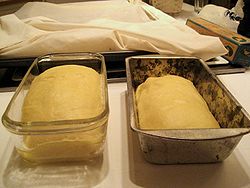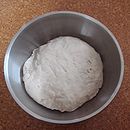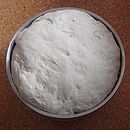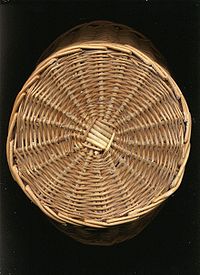
Proofing (baking technique)
Encyclopedia

Dough
Dough is a paste made out of any cereals or leguminous crops by mixing flour with a small amount of water and/or other liquid. This process is a precursor to making a wide variety of foodstuffs, particularly breads and bread-based items , flatbreads, noodles, pastry, and similar items)...
-rise step before baking
Baking
Baking is the technique of prolonged cooking of food by dry heat acting by convection, and not by radiation, normally in an oven, but also in hot ashes, or on hot stones. It is primarily used for the preparation of bread, cakes, pastries and pies, tarts, quiches, cookies and crackers. Such items...
, and refers to a specific rest period within the more generalized process known as fermentation
Fermentation (food)
Fermentation in food processing typically is the conversion of carbohydrates to alcohols and carbon dioxide or organic acids using yeasts, bacteria, or a combination thereof, under anaerobic conditions. Fermentation in simple terms is the chemical conversion of sugars into ethanol...
. Fermentation is a step in creating yeast
Yeast
Yeasts are eukaryotic micro-organisms classified in the kingdom Fungi, with 1,500 species currently described estimated to be only 1% of all fungal species. Most reproduce asexually by mitosis, and many do so by an asymmetric division process called budding...
breads and baked goods
Baking
Baking is the technique of prolonged cooking of food by dry heat acting by convection, and not by radiation, normally in an oven, but also in hot ashes, or on hot stones. It is primarily used for the preparation of bread, cakes, pastries and pies, tarts, quiches, cookies and crackers. Such items...
where the yeast is allowed to leaven the dough.
Fermentation rest periods are not often explicitly named, and normally appear in recipes as "Allow dough to rise."
In a less-specific sense with usage reminiscent to fermentation, proofing refers to yeasts' feeding on some type of sugar. As the term is used in some cookbooks intended for home use, it refers to testing the viability of one's yeast by mixing it with a small amount of warm water and sugar, and waiting until the mixture becomes foamy by the action of the yeast. Typically, using US customary units, ¼ cup (≈ 59.1 mL) water at 105–115 °F (40.6–46.1 °C) and ½ teaspoon (≈ 2.5 mL) of sugar are used. While this sugar may be sucrose
Sucrose
Sucrose is the organic compound commonly known as table sugar and sometimes called saccharose. A white, odorless, crystalline powder with a sweet taste, it is best known for its role in human nutrition. The molecule is a disaccharide composed of glucose and fructose with the molecular formula...
, instead it may be glucose
Glucose
Glucose is a simple sugar and an important carbohydrate in biology. Cells use it as the primary source of energy and a metabolic intermediate...
, typically enzyme-derived from starch
Starch
Starch or amylum is a carbohydrate consisting of a large number of glucose units joined together by glycosidic bonds. This polysaccharide is produced by all green plants as an energy store...
.
Proofing yeast may refer to the process of first dissolving yeast in warm water, a needed hydration step when using Active Dry Yeast
Baker's yeast
Baker's yeast is the common name for the strains of yeast commonly used as a leavening agent in baking bread and bakery products, where it converts the fermentable sugars present in the dough into carbon dioxide and ethanol...
. To hydrate the yeast, the weight of water required may be calculated: . In one variant of the sponge
Sponge and dough
The sponge and dough method is a two-step bread making process: in the first step a sponge is made and allowed to ferment for a period of time, and in the second step the sponge is added to the rest of the ingredients; this is known as the final dough. In this usage, synonyms for sponge are yeast...
technique known as poolish, proofing the yeast is the process step prior to feeding the yeast any carbohydrate.
Dough Processes



Autolyse
Autolysis (biology)
In biology, autolysis, more commonly known as self-digestion, refers to the destruction of a cell through the action of its own enzymes. It may also refer to the digestion of an enzyme by another molecule of the same enzyme....
is an optional dough process. It refers to a period of rest after the initial mixing of flour
Flour
Flour is a powder which is made by grinding cereal grains, other seeds or roots . It is the main ingredient of bread, which is a staple food for many cultures, making the availability of adequate supplies of flour a major economic and political issue at various times throughout history...
and water, a rest period that occurs sequentially before the addition of yeast and other ingredients. This rest period allows for better absorption of water and helps the gluten
Gluten
Gluten is a protein composite found in foods processed from wheat and related grain species, including barley and rye...
and starches to align. Breads made with autolysed dough are easier to form into shapes and have more volume and improved structure.
Fermentation typically begins when viable yeast or a starter culture is added to flour and water. During fermentation, yeast converts glucose and other carbohydrates to carbon dioxide
Carbon dioxide
Carbon dioxide is a naturally occurring chemical compound composed of two oxygen atoms covalently bonded to a single carbon atom...
gas which makes the dough rise, and alcohol which gives the baked bread flavor.
Depending on a bread's recipe, different bread varieties will have different process requirements. These are generally classified as either straight or sponge dough processes. Some straight doughs will only require a single mixing period while others, particularly sponge doughs, will need multiple periods. Between rest stages of fermentation recipes will often instruct a cook to "punch down" or "deflate" the dough to expel gas from carbon-dioxide bubbles which have formed.
Overproofing occurs when a fermenting dough has rested too long. Its bubbles have grown so large that they've popped and tunneled, and if baked at this point would result in poor structure. Length of rest periods, including proofing, can be determined by time at specific temperatures or by characteristics. Often the "poke method" is used to determine if a dough has risen long enough. If the dough, when poked, springs back immediately it is underproofed and needs more time.
Retarding may occur at any time during fermentation and is accomplished by placing the dough into a dough retarder, refrigerator, or other cold environment to slow the activity of the yeast. The retarding stage is often used in sourdough
Sourdough
Sourdough is a dough containing a Lactobacillus culture, usually in symbiotic combination with yeasts. It is one of two principal means of biological leavening in bread baking, along with the use of cultivated forms of yeast . It is of particular importance in baking rye-based breads, where yeast...
bread recipes to allow the bread to develop its characteristic flavor. A cold fermentation stage is sometimes used to develop flavor in other artisan breads, with a part of the dough ("pre-ferment") before the final mixing, with the entire dough during bulk fermentation, or in the final fermentation stages after shaping.
Proofing equipment

A dough proofer is a chamber used in baking that encourages fermentation of dough by yeast through warm temperatures and controlled humidity. The warm temperatures increase the activity of the yeast, resulting in increased carbon dioxide production and a higher, faster rise. Dough is typically allowed to rise in the proofer before baking
Baking
Baking is the technique of prolonged cooking of food by dry heat acting by convection, and not by radiation, normally in an oven, but also in hot ashes, or on hot stones. It is primarily used for the preparation of bread, cakes, pastries and pies, tarts, quiches, cookies and crackers. Such items...
.
A dough retarder is a refrigerator
Refrigerator
A refrigerator is a common household appliance that consists of a thermally insulated compartment and a heat pump that transfers heat from the inside of the fridge to its external environment so that the inside of the fridge is cooled to a temperature below the ambient temperature of the room...
used to control the fermentation of yeast when proofing dough. Lowering the temperature of the dough produces a slower, longer rise with more varied fermentation products, resulting in more complex flavors. In sourdough bread-making, cold decreases the activity of wild yeast relative to the Lactobacilli
Lactobacillus
Lactobacillus is a genus of Gram-positive facultative anaerobic or microaerophilic rod-shaped bacteria. They are a major part of the lactic acid bacteria group, named as such because most of its members convert lactose and other sugars to lactic acid. They are common and usually benign...
, which produce flavoring products such as lactic acid
Lactic acid
Lactic acid, also known as milk acid, is a chemical compound that plays a role in various biochemical processes and was first isolated in 1780 by the Swedish chemist Carl Wilhelm Scheele. Lactic acid is a carboxylic acid with the chemical formula C3H6O3...
and acetic acid
Acetic acid
Acetic acid is an organic compound with the chemical formula CH3CO2H . It is a colourless liquid that when undiluted is also called glacial acetic acid. Acetic acid is the main component of vinegar , and has a distinctive sour taste and pungent smell...
. Dough that is retarded before baking results in a more sour loaf. To prevent the dough from drying, air flow in the dough retarder is kept to a minimum. Home bakers may use cloth to cover dough that is kept for a longer period in the refrigerator.
A banneton is a type of basket used to provide structure for the sourdough
Sourdough
Sourdough is a dough containing a Lactobacillus culture, usually in symbiotic combination with yeasts. It is one of two principal means of biological leavening in bread baking, along with the use of cultivated forms of yeast . It is of particular importance in baking rye-based breads, where yeast...
breads during proofing. Proofing baskets are distinct from loaf pans
Bread pan
A bread pan is a kitchen utensil in the form of a container in which bread is baked. Its function is to shape bread while it is rising during baking. The most common shape of the bread pan is the loaf - a convenient form from which usable slices of bread may be cut. The bread pan is made from a...
in that the bread is normally removed from these baskets before baking. Traditionally these baskets are made out of wicker
Wicker
Wicker is hard woven fiber formed into a rigid material, usually used for baskets or furniture. Wicker is often made of material of plant origin, but plastic fibers are also used....
, but many modern proofing baskets are made out of silicone
Silicone
Silicones are inert, synthetic compounds with a variety of forms and uses. Typically heat-resistant and rubber-like, they are used in sealants, adhesives, lubricants, medical applications , cookware, and insulation....
or plastic. Frequently a banneton will have a cloth liner to prevent dough from sticking to the sides of the basket - though some have no such cloth. These baskets are used both to provide the loaf with shape and to wick moisture from the crust. Banneton baskets are also known as Brotform or proofing baskets. Alternatively, a couche or proofing cloth can be used to proof dough on or under. Couche are generally made of linen or other coarse material which the dough will not stick to and are left unwashed so as to let yeast and flour collect in them, aiding the proofing process. A banneton is used for round loaves, called boules, and a couche is typically used for longer loaves such as baguettes.
Further reading
- Jeffrey Hamelman (2004). Bread: A Baker's Book of Techniques and Recipes. John Wiley & Sons, Inc. ISBN 978-0-471-16857-7
- Peter Reinhart (1998). Crust & Crumb: Master Formulas for Serious Bread Bakers. Ten Speed Press. ISBN 978-1-58008-003-3
- Nancy SilvertonNancy SilvertonNancy Silverton is an American chef and baker who is the author of several cookbooks and has been at the forefront of efforts to revitalize sourdough and artisan breads in the United States.-Background and career:...
(1996). Breads from the La Brea Bakery. Villard Books. ISBN 0-679-40907-6 (USA)

